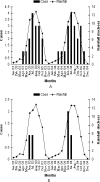Molecular characterization of Cryptosporidium spp. from children in Kolkata, India
- PMID: 16971647
- PMCID: PMC1698361
- DOI: 10.1128/JCM.00091-06
Molecular characterization of Cryptosporidium spp. from children in Kolkata, India
Abstract
The intracellular parasite Cryptosporidium is responsible for severe diarrhea in immunocompromised persons in developing countries. Few studies on the characterization of the parasite in India are available. In this study, molecular characterization of the parasite from diarrheic children was carried out by PCR-restriction fragment length polymorphism analysis. At least three genotypes were identified. Out of 40 positive samples, 35 were positive for C. hominis, 4 were positive for C. parvum, and 1 was positive for C. felis. This study clearly suggests that cryptosporidiosis in this region is caused largely by anthroponotic transmission.
Figures



References
-
- Awad-El-Kariem, F. A., H. A. Robinson, D. A. Dyson, D. Evans, S. Wright, and M. T. Fox. 1995. Differentiation between human and animal strains of Cryptosporidium parvum using isoenzyme typing. Parasitology 110:129-132. - PubMed
-
- Colford, J. M., I. B. Tager, A. M. Hirozawa, G. F. Lemp, T. Aragon, and C. Petersen. 1996. Cryptosporidiosis among patients infected with human immunodeficiency virus. Am. J. Epidemiol. 144:807-816. - PubMed
-
- Das, P. 1996. Cryptosporidium related diarrhea. Ind. J. Med. Res. 104:86-95. - PubMed
MeSH terms
Associated data
- Actions
- Actions
- Actions
LinkOut - more resources
Full Text Sources
Molecular Biology Databases
Miscellaneous

